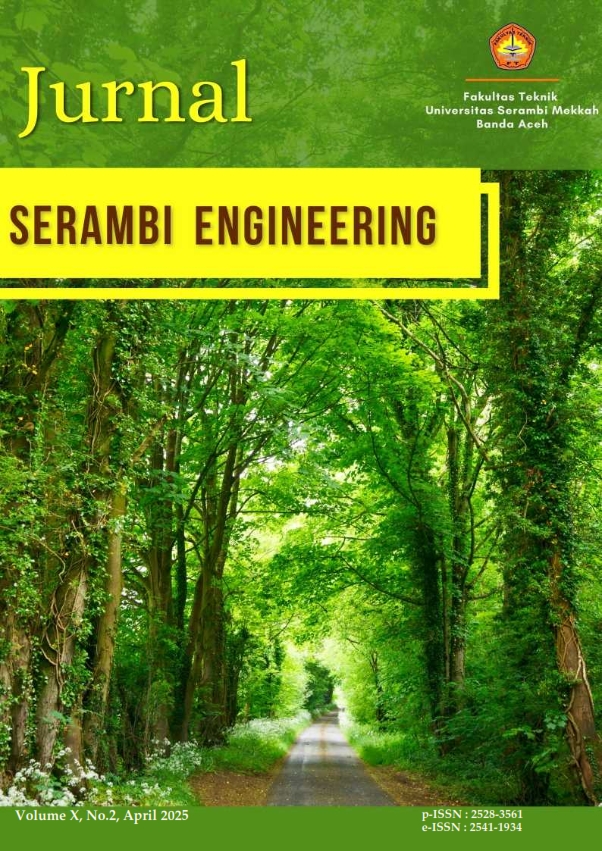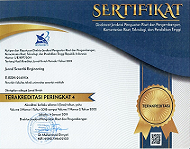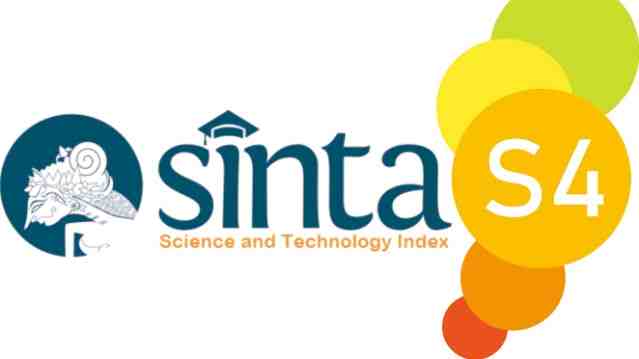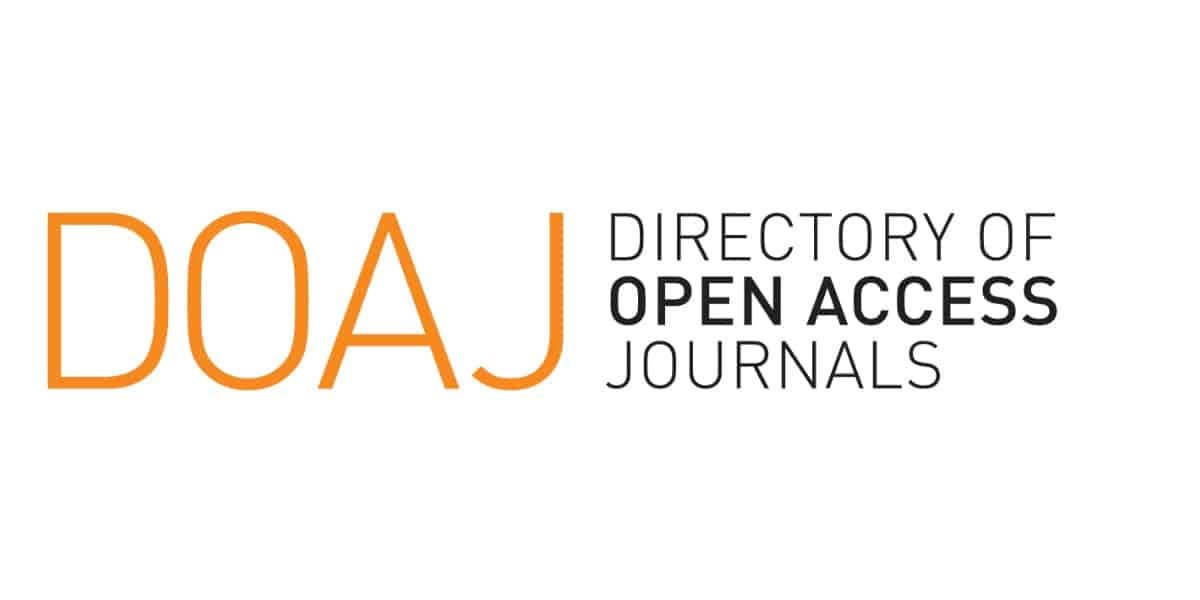Klasifikasi Kelayakan Kualitas Air Tanah Kota Surabaya Menggunakan Fuzzy Tipe Mamdani
Keywords:
Groundwater , Fuzzy, Mamdani, classification, water qualityAbstract
Surabaya is the second largest city in Indonesia which is densely populated. The need for fresh water for the population of Surabaya is 4.61 m3/second, where many still use groundwater as a source of clean water. In this research, groundwater feasibility test will be carried out using 6 parameters at 31 points in the city of Surabaya. The water quality parameters to be tested are turbidity, temperature, pH, hardness (CaCO3), E. coli bacteria, and Dissolved Oxygen. The method used in the classification of ground water feasibility is the Mamdani method because it has a broad field coverage and is easily understood by humans. The results showed that the average quality of groundwater in the city of Surabaya was: turbidity 2.34 NTU, temperature 28.6 oC, pH 7.4, hardness (CaCO3) 349.67 mg/liter, and E. coli bacteria 0,13 CFU/100 ml, and DO 1.93 mg/l. The results of the evaluation of the feasibility of groundwater are compared with water quality parameters for hygiene and sanitation purposed based on PerMenKes No. 32 of 2017, all parameters have met the quality standards and are suitable as a source of clean water except for the parameter of E. coli bacteria. Based on the modeling using Fuzzy Mamdani type, there are ten sampling points that have groundwater that is not suitable as a source of clean water. Management recommendations for the protection of groundwater resources in the city of Surabaya for the community and for decision making by the government are disinfection using chlorine.
References
[1] Zulfikar, W.B., Jumadi, Prasetyo, P.K, dan Ramdhani, M.A. 2018. Implementation of Mamdani Fuzzy Method in Employee Promotion System. Proceedings of The 2nd Annual Applied Science and Engineering Conference (AASEC). Hal. 1-5. DOI: 10.1088/1757-899X/288/1/012147
[2] Afifi, F.W., Fitriyah, H., dan Setiawan, E. 2021. Sistem Klasifikasi Mutu Air PDAM Berdasarkan Zat Terlarut, pH, dan Turbidity Menggunakan Metode Fuzzy Sugeno Berbasis Arduino. Jurnal Pengembangan Teknologi Informasi dan Ilmu Komputer. Vol. V, No. 8, Hal: 3578-3583.
[3] Kaur, A. and Kaur, A. 2012. Comparison of Mamdani-Type and Sugeno-Type Fuzzy Inference Systems for Air Conditioning System. International Journal of Soft Computing and Engineering (IJSCE), Vol. 2, Issue 2, pp. 323–325.
[4] Badan Pusat Statistik Kota Surabaya. 2018. Kota Surabaya dalam Angka 2018. Surabaya, Indonesia
[5] Ramakrishnaiah, C.R., Sadashivaiah, C., and Ranganna, G. 2009. Assessment of Water Quality Index for the Groundwater in Tumkur Taluk, Karnataka State, India. E-Journal of Chemistry, Vol. 6, No. 2, pp. 523–530. DOI: 10.1155/2009/757424
[6] Direktorat Pengembangan Air Minum Direktorat Jenderal Cipta Karya Departemen Pekerjaan Umum Republik Indonesia. 2005. Ringkasan Eksekutif Dialog Penajaman Pola Konsumsi dan Kebutuhan Pokok Minimal (Air Minum). Jakarta, Indonesia.
[7] Scannapieco, D., Naddeo, V., Zarra, T., and Belgiorno, V. 2012. River Water Quality Assessment : A Comparison of Binary- and Fuzzy Logic-based Approaches. Ecological Engineering, Vol. 47, PP. 132–140. DOI: 10.1016/j.ecoleng.2012.06.015
[8] I. Elamvazuthi, P. Vasant, and J. F. Webb, “The Application of Mamdani Fuzzy Model for Auto Zoom Function of a Digital Camera,”. International Journal of Computer Sience and Information Security, Vol. 6, No. 3, pp. 244–249, 2010.
[9] Menteri Kesehatan Republik Indonesia. 2017. “Peraturan Menteri Kesehatan No. 32 Tahun 2017 tentang Standar Baku Mutu Kesehatan Lingkungan dan Persyaratan Kesehatan Air untuk Keperluan Higiene Sanitasi, Kolam Renang, Solus Per Aqua”. Jakarta
[10] Vadiati, M., Asghari-Moghaddam, A., Nakhaei, M., Adamowski, J. and Akbarzadeh, A.H. 2016. “A Fuzzy-Logic Based Decision-Making Approach For Identification of Groundwater Quality Based on Groundwater Quality Indices,” Journal of Environmental Management., Vol. 184, Part 2, pp. 255–270
[11] Nasr, A.S., Rezael, M., and Barmaki, M.D. 2012. Analysis of Groundwater Quality using Mamdani Fuzzy Inference System (MFIS) in Yazd Province, Iran. International Journal of Computer Application, Vol. 59, No. 7. Pp. 45-53
[12] Persada, R.C.P. dan Purnomo, A. 2018. Analisis Air Baku Prioritas Skala Kota (Studi Kasus: PDAM Surya Sembada Surabaya). Jurnal Teknik ITS, Vol. 7, No. 1, Hal: F224-F227
[13] Hiwarkar T.A. and Iyer, R.S. 2013. “New Applications of Soft Computing, Artificial Intelligence, Fuzzy Logic & Genetic Algorithm in Bioinformatics”. International Journal of Computer Science and Mobile Computing, Vol. 2. Issue 5, pp. 202-207
[14] Said, N.I. 2008. Teknologi Pengolahan Air Minum “Teori dan Pengalaman Praktis”. Jakarta: Pusat Teknologi Lingkungan, Deputi Bidang Teknologi Pengebangan Sumberdaya Alam, Badan Pengkajian dan Penerapan Teknologi
[15] Said, N. I. dan Widayat, W. 2013. Teknologi Pengolahan Air Limbah Rumah Sakit dengan Proses Biofilter Anaerob-Aerob. Jakarta: Pusat Teknologi Lingkungan, Deputi Bidang Teknologi Pengebangan Sumberdaya Alam, Badan Pengkajian dan Penerapan Teknologi
[16] Sari, W.E. Wahyunggoro, O., and Fauziati, S. 2016. A Comparative Study on Fuzzy Mamdani-Sugeno-Tsukamoto for the Childhood Tuberculosis Diagnosis. Proceedings of The 1st International Conference on Science and Technology 2015 (ICST-2015). Vol. 1775, Issue 1, pp. 070003-1 - 070003-6
[17] Tahir, R.B. 2016. “Analisis Sebaran Kadar Oksigen (O2) dan Kadar Oksigen Terlarut (Dissolved Oxygen) dengan Menggunakan Data in Situ dan Citra Satelir Landsat 8 (Studi Kasus: Wilayah Gili Iyang Kabupaten Sumenep). Tesis. Surabaya: Teknik Geomatika, Institut Teknologi Sepuluh Nopember
[18] Wardani, A.M., Pratama, B., Herlianna, C.D, Pratama, D.O., Janah, H.N.M., Tamara, L.A., Soliha, M. & Faizah, U.N. 2021. Konservasi Sumber Daya Air Guna Terjaganya Kualitas Serta Entitas Air Baku. Proceeding of Integrative Science Education Seminar. Vol. 1, No.1, pp. 117-126
Downloads
Published
Issue
Section
License
Copyright (c) 2025 Sulistiya Nengse, Dian Candra Rini Novitasari (Author)

This work is licensed under a Creative Commons Attribution 4.0 International License.

















